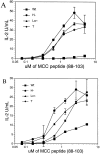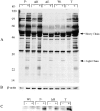Suppression of T and B lymphocyte activation by a Yersinia pseudotuberculosis virulence factor, yopH
- PMID: 10544205
- PMCID: PMC2195683
- DOI: 10.1084/jem.190.9.1343
Suppression of T and B lymphocyte activation by a Yersinia pseudotuberculosis virulence factor, yopH
Abstract
The acquired immune responses are crucial to the survival of Yersinia-infected animals. Mice lacking T cells are sensitive to Yersinia infection, and a humoral response to Yersinia can be protective. Diverse mechanisms for Yersinia to impair and evade the host innate immune defense have been suggested, but the effects of Yersinia on lymphocytes are not known. Here, we demonstrate that after a transient exposure to Y. pseudotuberculosis, T and B cells are impaired in their ability to be activated through their antigen receptors. T cells are inhibited in their ability to produce cytokines, and B cells are unable to upregulate surface expression of the costimulatory molecule, B7.2, in response to antigenic stimulation. The block of lymphocyte activation results from the inhibition of early phosphorylation events of the antigen receptor signaling complex. Through the use of Y. pseudotuberculosis mutants, we show that the inhibitory effect in both T cells and B cells is dependent on the production of Yersinia outermembrane protein (Yop) H, a tyrosine phosphatase. Our results suggest a mechanism by which the pathogenic bacteria may modulate a wide range of T and B cell-mediated immune responses.
Figures






References
-
- Finlay B., Cossart P. Exploitation of mammalian host cell functions by bacterial pathogens. Science. 1997;276:718–725. - PubMed
-
- Sherris, J., and K. Ryan. 1994. Sherris Medical Microbiology. 3rd ed. K. Ryan, editor. Appleton & Lange, East Norwalk, CT. 890 pp.
-
- Pancholi P., Mirza A., Bhardwaj N., Steinman R.M. Sequestration from immune CD4+ T cells of mycobacteria growing in human macrophages. Science. 1993;260:984–986. - PubMed
Publication types
MeSH terms
Substances
LinkOut - more resources
Full Text Sources
Research Materials

